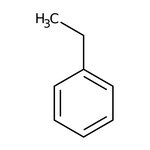Search Thermo Fisher Scientific
Éthylbenzène, 99 %, Thermo Scientific Chemicals



Éthylbenzène, 99 %, Thermo Scientific Chemicals
Identifiants chimiques
Spécifications
Description
This Thermo Scientific Chemicals brand product was originally part of the Alfa Aesar product portfolio. Some documentation and label information may refer to the legacy brand. The original Alfa Aesar product / item code or SKU reference has not changed as a part of the brand transition to Thermo Scientific Chemicals.
L’éthylbenzène est utilisé comme solvant pour les adhésifs en caoutchouc, les vernis, les résines, les peintures et les revêtements. Il agit comme intermédiaire dans la préparation du styrène. Il est également utilisé comme additif de carburant. Il est ajouté à l’essence comme agent antidétonation, réduisant ainsi le cliquetis du moteur et augmentant l’indice d’octane. En outre, il est utilisé dans le processus de récupération du gaz naturel.
Solubilité
Miscible avec l’alcool, l’alcool éthylique, le benzène, l’éther éthylique, de tétrachlorure de carbone, les solvants organiques, le dioxyde de soufre et l’éther. Légèrement miscible au chloroforme. Non miscible avec l’eau et l’ammoniaque.
Remarques
Incompatible avec les agents oxydants forts.
Figures
Documentation et téléchargements
Certificats
Foire aux questions (FAQ)
Citations et références
Sécurité et manipulation
Classification of the substance or mixture
CLP classification - Regulation(EC) No 1272/2008
Label Elements
Signal Word
Danger
Hazard Statements
H304 - May be fatal if swallowed and enters airways
H332 - Harmful if inhaled
H340 - May cause genetic defects
H350 - May cause cancer
H373 - May cause damage to organs through prolonged or repeated exposure
H412 - Harmful to aquatic life with long lasting effects
Physical Hazards
H225 - Highly flammable liquid and vapor
Precautionary Statements
P210 - Keep away from heat, hot surfaces, sparks, open flames and other ignition sources. No smoking
P280 - Wear protective gloves/protective clothing/eye protection/face protection
P301 + P310 - IF SWALLOWED: Immediately call a POISON CENTER or doctor/physician
P303 + P361 + P353 - IF ON SKIN (or hair): Take off immediately all contaminated clothing. Rinse skin with water or shower
P304 + P340 - IF INHALED: Remove person to fresh air and keep comfortable for breathing
P331 - Do NOT induce vomiting
Additional EU labelling
Restricted to professional users